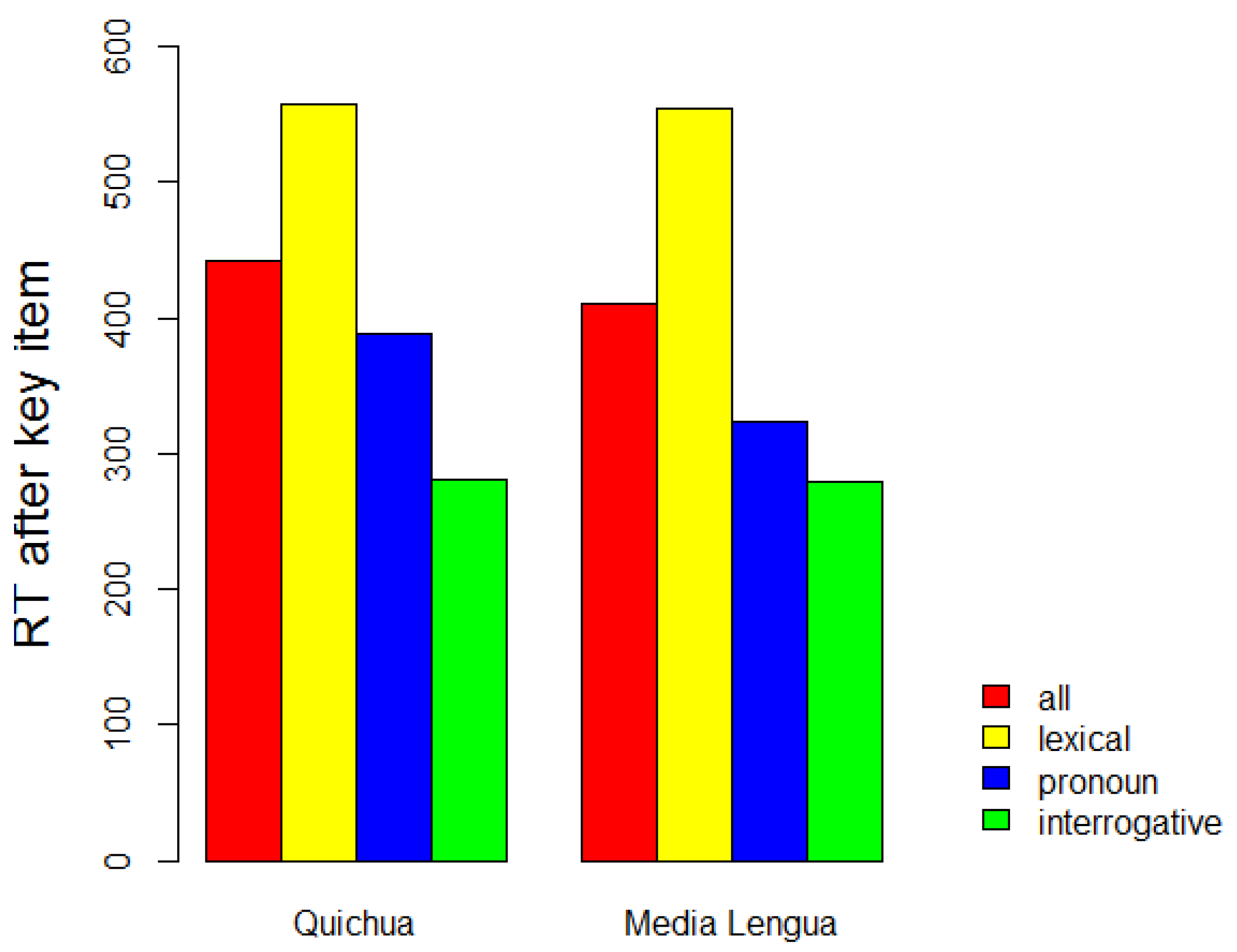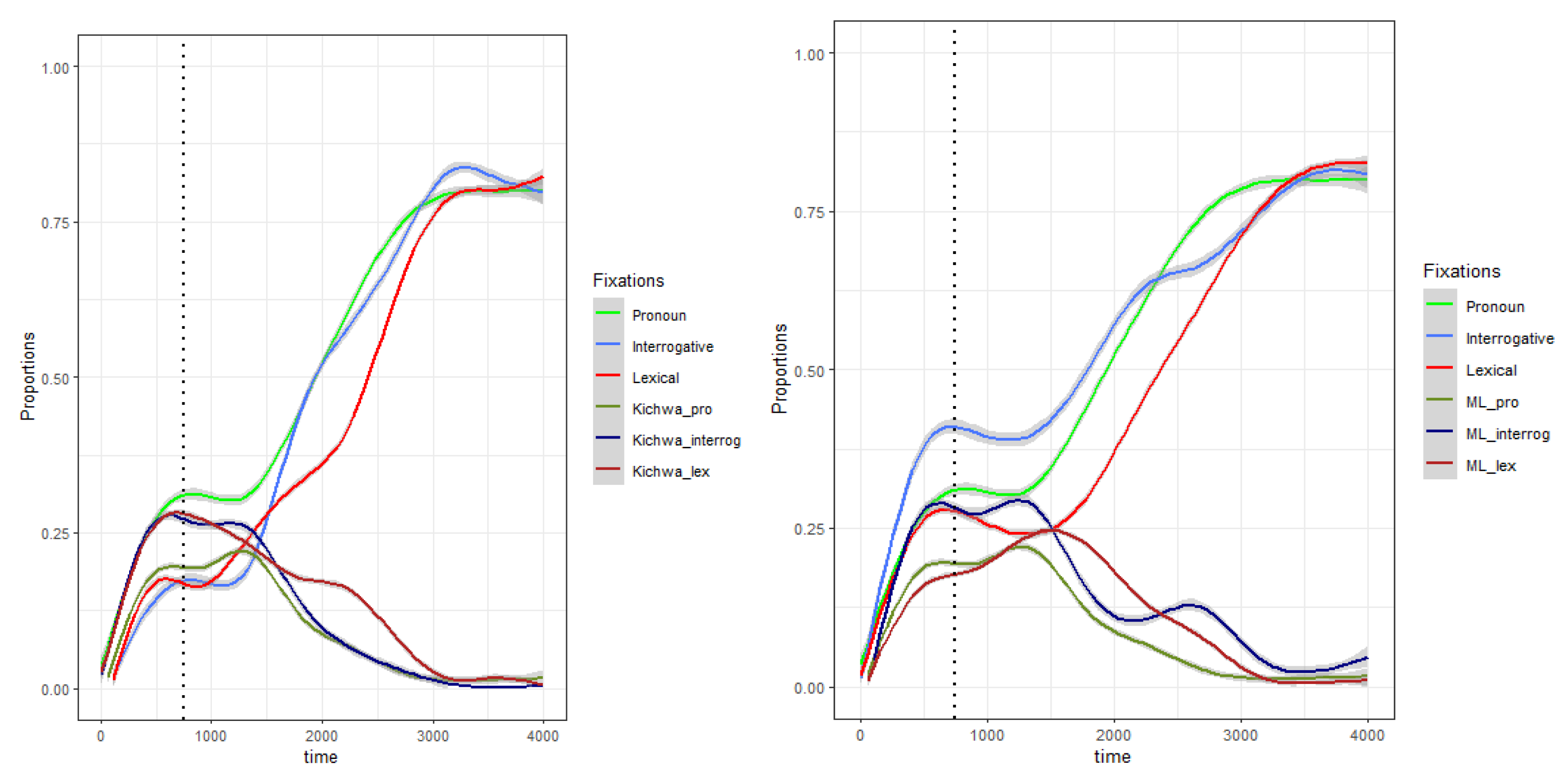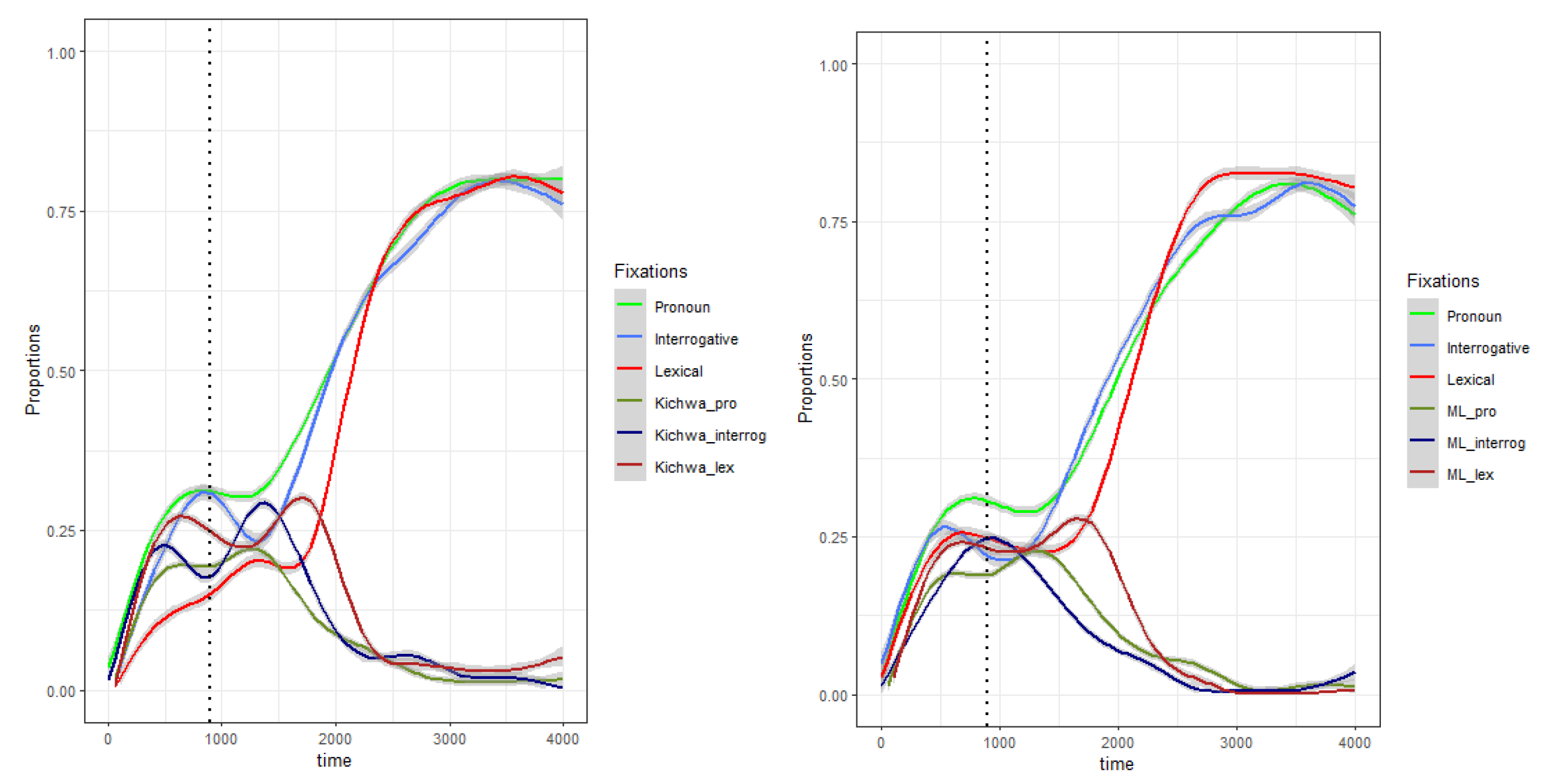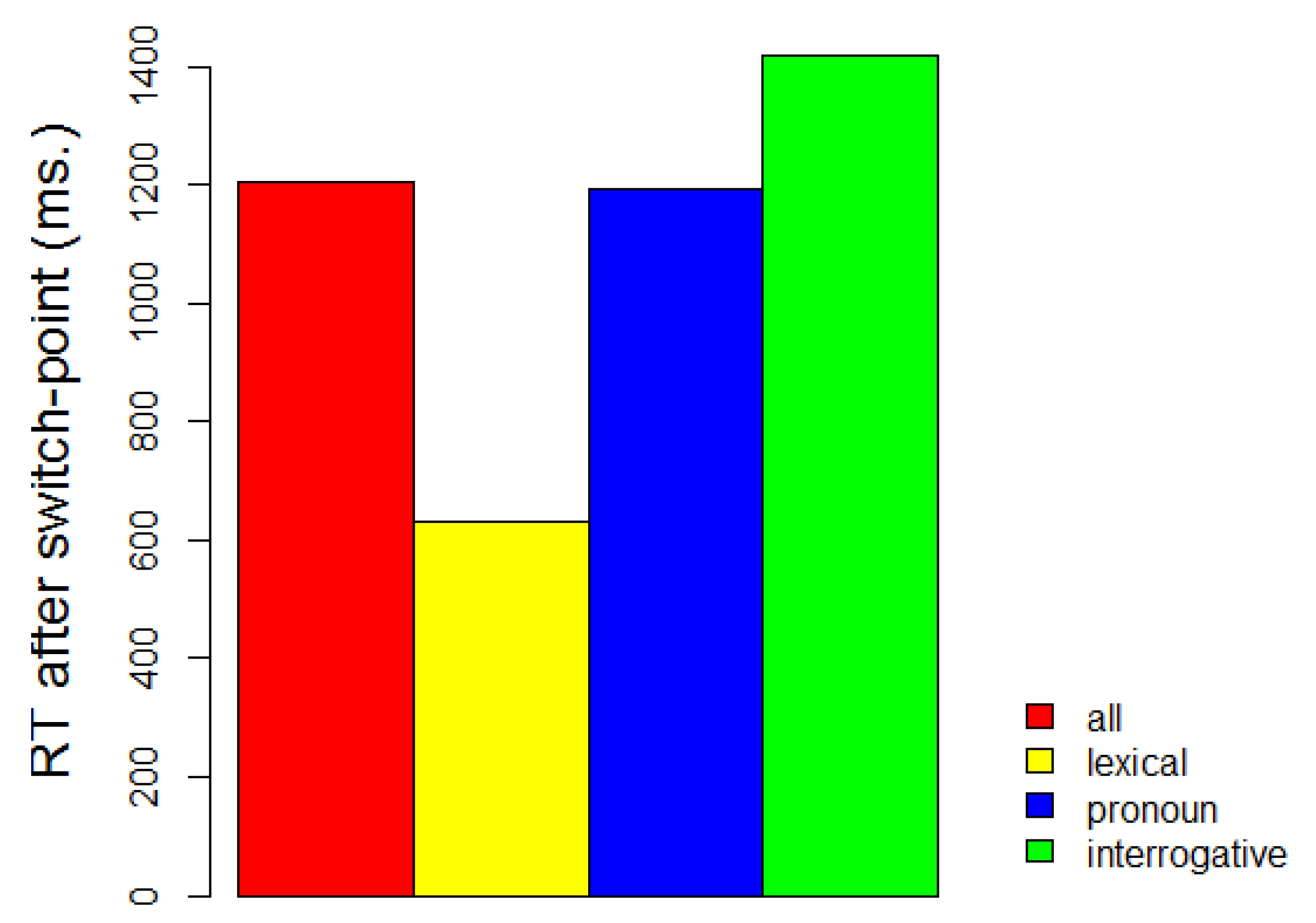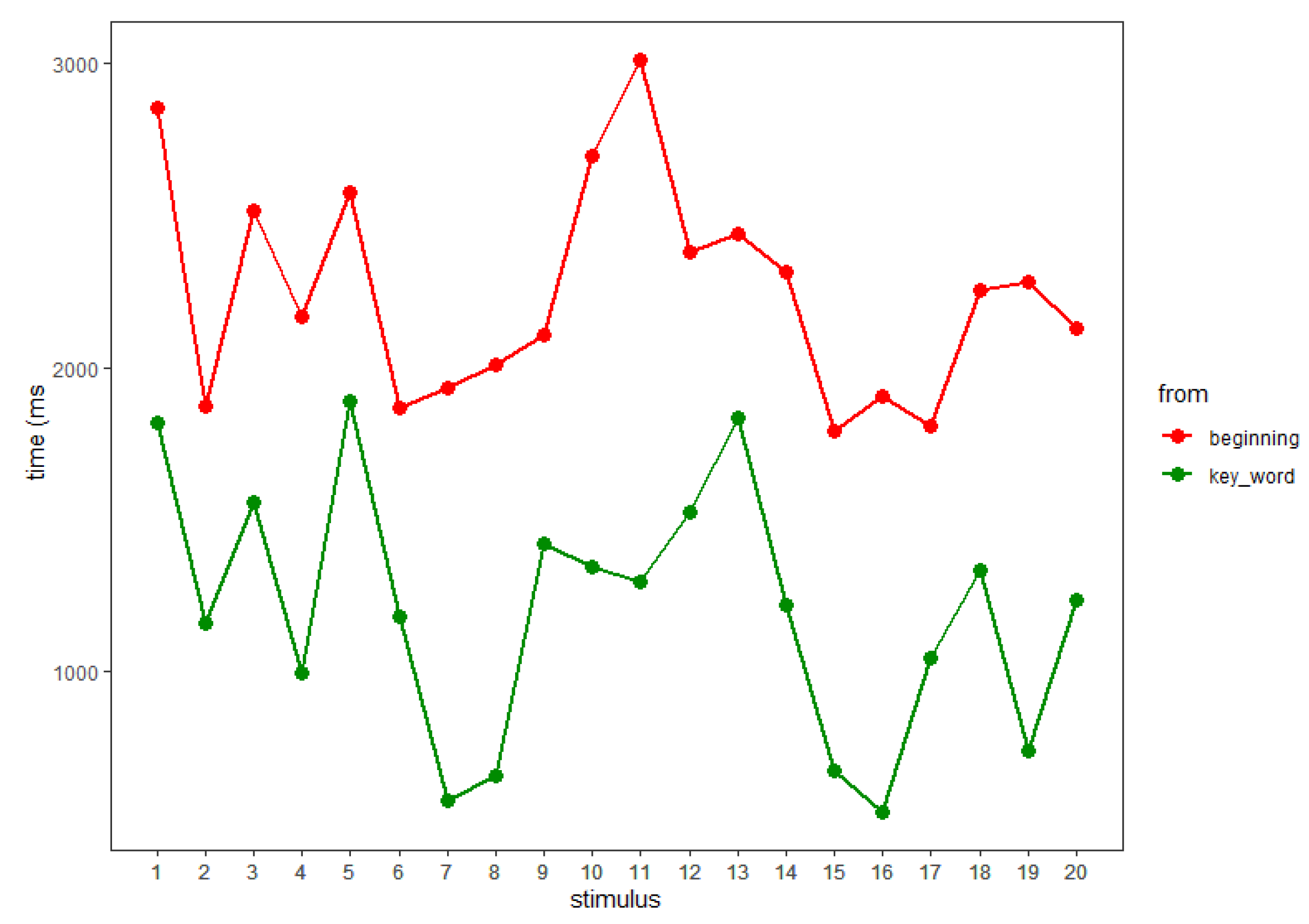1. Introduction
Many bilingual speakers switch between their languages during informal speech with interlocutors who share the same languages. This code-switching is frequently subject to pragmatic constraints, including topics, assertions of identity, and a variety of speech acts such as requesting, persuading, or admonishing. When bilingual code-switching takes place smoothly and without hesitation within the bounds of a single utterance, it is particularly challenging to linguistic and psychological models grounded in a single language, because more than two monolingual grammars are involved (
Grosjean 1989). Such intra-sentential code-switching may appear chaotic and unconstrained to outsiders, but a large body of research on numerous bilingual dyads—frequently confirmed by naïve speakers’ intuitions—has shown that most intra-sentential switches do not violate the grammatical structures of either language, not only within the single-language segments but also at the points of transitions between languages (e.g.,
Poplack 1980;
Lipski 1977,
1978,
1985;
Muysken 2000). Although most bilingual speakers without training in linguistics do not have explicit knowledge of these general constraints, corpora of bilingual interactions reveal few violations in production, and a variety of interactive tasks such as acceptability judgments and elicited repetition have confirmed the robustness of general restrictions on the processing of intra-sentential language mixing, all circumscribed by the aforementioned “do no harm” admonitions (no grammatical violations in either language).
In addition to the need for general structural compatibility, some cross-linguistic observations suggest the possibility of more fine-grained constraints on intra-sentential code-switching based on the category of the elements involved, even when no grammatical rules are violated in either language. Two proposed constraints that emerged from seminal studies of Spanish–English code-switching, and which have subsequently been documented for other bilingual configurations, disfavor switches between subject pronouns and the following verb and between fronted interrogative words and the remainder of the utterance (e.g.,
Lipski 2018,
2020;
Muysken 2000;
Peñalosa 1980;
Woolford 1984)
1. Most proffered examples and counter-examples of code-switching restrictions based on grammatical categories run afoul of language-specific factors that confound the search for constraints on language mixing (e.g.,
Mahootian and Santorini 1996;
Prince and Pintzuk [1983] 2000;
Woolford 1983). For example, although general similarities can be observed, head-to-head structural comparison between Spanish and English subject pronouns is not feasible, because Spanish is a “null-subject” language in which verb inflection is sufficient to identify the subject of a sentence, whereas in English, subject pronouns must be overtly expressed. Similarly, fronted interrogative expressions in English typically require
do-support, e.g.,
Where does John live? What does John want? Spanish has no such structure, but in many varieties of Spanish, subject–verb inversion may accompany interrogatives:
¿Dónde vive Juan? “Where does Juan live?”
¿Qué quiere Juan? “What does Juan want?” In an attempt to move beyond such confounding factors, the following sections present online processing data from a unique bilingual speech community, whose languages share identical morphosyntax, while being sufficiently differentiated to ensure explicit recognition of code-switching. The possibly “special” status of subject pronouns and interrogatives in code-switching environments is approached directly, with code-switched stimuli, and indirectly, by determining whether rapid language recognition is facilitated by specific grammatical categories. For purposes of clarity, only a single intra-sentential code-switching configuration is targeted, namely alternation (in the sense of (
Muysken 2000)), for which assignment of a matrix language (
Myers-Scotton and Jake 2000;
Jake et al. 2002) is not at stake. The results reveal differential processing patterns for both subject pronouns and interrogatives even in the complete absence of grammatical divergence and implicate processing speed as a contributing factor.
2. A Limiting Test Case: Quichua and Media Lengua in Ecuador
Three small indigenous communities in northern Ecuador provide a unique opportunity to study restrictions on bilingual code-switching in the absence of any morphosyntactic differences between the languages. The languages are Imbabura Quichua (
Cole 1982) and what is referred to locally as
Media Lengua or
Chaupi Shimi (literally “half-language”). Despite the wryly humorous name, Media Lengua is a full language spoken natively together with Quichua in the communities of Pijal, Angla, and Casco Valenzuela in the northern Ecuadoran province of Imbabura and consists of Quichua morphosyntax, complete with all system morphemes, but with virtually all Quichua roots replaced by their Spanish equivalents. Media Lengua was first described in the 1970s for some communities in central Ecuador by
Muysken (
1979,
1981,
1988,
1997); it has now disappeared from this region (
Lipski 2019b;
Müller 2011;
Shappeck 2011), but is maintained robustly in the three aforementioned communities at least since the middle of the 20th century (
Gómez Rendón 2005,
2008;
Lipski 2019b;
Stewart 2011,
2013).
Quichua and Media Lengua not only share identical grammars, but also have lexically disjointed sets of words for the grammatical categories that have previously been implicated in code-switching research (e.g., pronouns and interrogative words). This makes it possible to isolate for study the processing of specific grammatical elements without ever violating any structural rules. If in the absence of any structural constraints, subject pronouns and interrogative words behave differently than open-class lexical items, this would support their status as “special”, for reasons yet to be determined. Examples of Quichua and Media Lengua can be found below, where Spanish-derived lexical roots are in italics (
nutro <
nuestro “our”;
amigo “friend”;
biya <
villa “town”;
bibi <
vivir “to live”). All system morphemes in this agglutinative language (suffixes, indicated here by dashes) are identical; only the lexical roots differ between the languages.
| Quichua |
| ñukanchik-ka | mashi-kuna-wan | ayllu-pi | kausa-nchik |
| Media Lengua |
| nutro-ka | amigo-kuna-wan | biya-pi | bibi-nchik |
| we-TOP | friend-PL-with | town-LOC | live-1.PL |
| “We live with our friends in the town [Otavalo]” |
Previous psycholinguistic research conducted with Quichua–Media Lengua bilinguals has demonstrated that speakers are able to reliably distinguish the two languages as well as putative mixtures (
Lipski 2017a,
2017b; also
Deibel 2020), and in a variety of language identification and elicited repetition tasks, both pronouns and interrogatives behaved differently from open-class lexical items (
Lipski 2017a,
2019a); in particular, these items triggered more “repairs” to deliberately mixed utterances. Because no grammatical constraints of either Quichua or Media Lengua are violated by switching languages at any particular point (e.g., after pronouns or interrogatives), the mixed utterances employed in the previous studies are clearly parsable, as evidenced, for example, by the ease with which they were translated (
Lipski 2017b,
2019b). Therefore, something in the speech signal other than a grammatical violation is responsible for the degraded acceptability of switches after pronouns and interrogatives in both production and processing
The current study expands the exploration of Quichua–Media Lengua bilingualism by examining the online processing of Quichua, Media Lengua, and code-switched utterances. The methodology employed is eye-tracking, which offers the advantage of excellent temporal resolution combined with a high signal-to-noise ratio (i.e., usable with a single presentation of stimulus items, unlike, e.g., electrophysiological techniques such as EEG/ERP—electroencephalography/event-related potentials). Moreover, eye-tracking can be carried out with highly portable equipment suitable for even the most challenging field settings and can be employed with naïve and non-literate participants as well as with languages that have no established written tradition. These features are crucial in working with participants in the present study, most of whom are farmers and herders or work in small rural businesses, with little formal education and no previous experience with experimental techniques or metalinguistic inquiries. All of the participants described below gave their informed consent for inclusion before they participated in the study. The study was conducted in accordance with the Declaration of Helsinki, and the protocol was approved by the Institutional Review Board of the Pennsylvania State University, protocol # 339971. All participants were compensated for their time.
3. Experiment 1: Language Identification through Eye-Tracking
Given that Quichua and Media Lengua share identical morphosyntactic frames with only lexical roots distinguishing the languages, it is possible to examine the factors that allow for online recognition of which language is being used. This can be done by varying the initial elements of test utterances and tracing the time course of language recognition. The first processing experiment was designed to probe for the possibly differential status of specific grammatical categories in enabling recognition of Quichua and Media Lengua. The experiment used eye-tracking with the visual world paradigm (
Huettig et al. 2011;
Tanenhaus and Trueswell 2006). Participants were asked to identify presented stimuli as either Quichua or Media Lengua as soon as they recognized the language of the stimulus, and the stimuli highlighted specific grammatical types. The purpose was to determine if grammatical categories of utterance initial elements modulated response time.
3.1. Participants
A total of 62 Quichua–Media Lengua adult bilinguals from the communities of Angla, Casco Valenzuela, and Pijal participated. None had known visual or auditory impairments. Participants were recruited by two respected community leaders, both of whom are teachers at the bilingual school in the community of Topo and who have worked with the author in previous research and are knowledgeable of the requisite linguistic characteristics.
3.2. Materials
A female native speaker of Quichua and Media Lengua from the community of Casco Valenzuela recorded 36 stimulus utterances, half of which were in Quichua and the other half in Media Lengua. All stimulus utterances began with one of two ambiguous carrier phrases, which are identical in Quichua and Media Lengua. One phrase was felicitous for locative reference, while the other implied temporal reference. The carrier phrases are below.
| Otabalo-pi-ka |
| Otavalo-LOC-TOP |
| “In Otavalo” |
| sabado-ta-ka |
| Saturday-ACC-TOP |
| “on Saturday” |
A total of 12 of the stimuli began with a subject pronoun after the carrier phrase (six in Quichua, six in Media Lengua, divided evenly between the two carrier phrases), 12 stimuli began with interrogative words following the carrier phrase, and 12 began with common language-specific lexical items.
A visual image (shown in
Appendix A) was created with an icon suggestive of Media Lengua (a couple, one of which was clearly indigenous and one who had a more European appearance) in the upper-left corner and an image suggestive of Quichua (a woman in traditional indigenous garb) in the upper-right corner. This image was combined with the recorded stimuli into a series of video clips and incorporated into the Tobii Pro Studio software suite. The resulting experiment began with recorded instructions (in both Quichua and Media Lengua), and a fixation cross appeared between each stimulus, to fix the gaze in the center of the screen. The experiment was conducted with a Tobii Pro X3-120 portable eye-tracking camera (120 Hz sampling rate). This device attaches to the bottom of a computer screen, requires no head rest or other external infrastructure, and is designed to compensate for participants’ head movements.
3.3. Procedure
Participants were seated in front of a laptop computer to which the eye-tracking camera was attached. They listened to the stimuli through over-the-ear headphones and were instructed (with pre-recorded instructions repeated in Quichua and Media Lengua) to look at the target image as soon as they recognized which language they were hearing; they were also asked to move the mouse cursor to the appropriate image, then return it to the central fixation point between stimuli. A practice session preceded the experimental trials.
3.4. Results and Discussion
After eliminating incorrect responses by visually inspecting the replay video files, the output data from the eye-tracking system were analyzed in R
2, and the point at which the proportion of gazes to the target image as opposed to the non-target reached statistical significance was determined with the eyetrackingR package (
Dink and Ferguson 2015), using the bootstrapping option with 1000 resamples (the basic
t-test,
t-test with Bonfaronni correction, and Holm’s test were also measured and in most cases were very close to the bootstrapped values). From the point at which gaze proportion to the target reached significance, a conservative value of 200 ms was subtracted to account for the time generally required to initiate a language-triggered saccade (
Altmann 2011) in order to identify the word that had triggered the gaze to the target. The audio files were imported into PRAAT (
Boersma and Weenink 1999–2005), and by means of a script, the appropriate points of language recognition were located on the corresponding text grids. The overall results are presented in
Table 1 and
Figure 1. There were no significant differences between Quichua and Media Lengua for any of the categories. Interrogatives and subject pronouns following the language-neutral carrier phrases triggered significant gaze shifts to the target images immediately after the key items (100%), while gazes to the targets were sometimes delayed when a lexical item immediately followed the carrier phrase (40%).
A repeated-measures ANOVA performed on the log-transformed times revealed a large main effect for grammatical type:
F(3, 31) = 5.787,
p < 0.003. A post-hoc Tukey test showed a significant difference between subject pronouns and lexical items (
p = 0.01) and between interrogatives and lexical items (
p = 0.006), but not between interrogatives and pronouns (
p = 0.95). From these figures, it can be deduced that immediate language recognition is facilitated by subject pronouns or interrogatives as opposed to open-class lexical items.
Figure 2 and
Figure 3 show composite gaze tracks for both Media Lengua and Quichua stimuli, where the relative fixation times can also be seen.
4. Experiment 2: Language-Switching Recognition through Eye-Tracking
The role of specific items in the time course of language processing is crucial in code-switching contexts, because acknowledgement of a switch depends on the assignment of each word to one language or the other. The second experiment probed participants’ recognition of intra-sentential code-switches, with transitions from Quichua to Media Lengua and Media Lengua to Quichua following pronouns, interrogatives, and lexical items. The purpose was to determine whether reaction time for processing and acknowledging switches as measured by gaze-tracking varied depending on the grammatical configuration at the switch point and whether there was any correlation between the facilitating categories detected in Experiment #1 and the time course of online acknowledgement of code-switching.
4.1. Participants
The same 62 Quichua–Media Lengua bilinguals who had participated in the language-identification task performed the language-switching task at a different time.
3 4.2. Materials
A female native speaker of Quichua and Media Lengua recorded 20 stimulus utterances, 10 of which began in Quichua and switched to Media Lengua approximately halfway through, and the other 10 containing mid-sentence switches from Media Lengua to Quichua. Six of the stimuli had switches following a subject pronoun (three from Quichua to Media Lengua and three from Media Lengua to Quichua), eight had switches after interrogative words (four for each switching direction), and the remaining six contained switches after lexical items. The recordings were combined with a fixed image (shown in
Appendix A) into a video file for presentation. The image contained a right-pointing fixation arrow on the left side of the screen and an image of a multi-faceted “mixed” face on the right side of the screen. In order to circumvent the natural tendency to look first at the center of the screen, between stimuli, a dynamic video was presented, in which the fixation arrow moved from right to left, ending in the position of the stationary fixation arrow in the stimulus videos. Gaze-tracking replays verified that participants’ eyes followed the moving arrow and generally remained in this position as the following stimulus items were presented.
4.3. Procedure
Participants were seated in front of a laptop computer to which the Tobii X3-120 eye-tracking camera was attached. They listened to the stimuli through headphones, and following a brief demonstration video and demonstration by the author, the task began with pre-recorded instructions in both Quichua and Media Lengua. Participants were asked to begin with their gaze on the left fixation arrow and to look quickly towards the mixed image (and move the mouse cursor as well) as soon as they detected a language switch.
4.4. Results and Discussion
Unlike in the language-identification task, in which gaze shifts to the target occurred at most a single word beyond the key stimulus item, in the language-switching task, significant gazes to the target image usually occurred after the offset of the (short) stimulus utterances.
Table 2 presents the time past the offset of the key items at which the proportion of gazes to the target image became significant, and
Figure 4 displays the results visually. A repeated-measures ANOVA on the log-transformed times of significant gaze to the switch-image also revealed a main effect for the time following the key grammatical type:
F(2, 19) = 11.79,
p < 0.0005; a post-hoc Tukey test confirms significant differences (
p < 0.02) between subject pronouns and lexical items and between interrogatives and lexical items (
p < 0.0004) but not between pronouns and interrogatives (
p = 0.20).
Immediately noticeable is the fact that the critical times in the switching task are the mirror image of those stemming from the language-identification experiment: acknowledgement of an intra-sentential switch took the longest when the switch occurred after an interrogative element or subject pronoun and was considerably quicker when the switch occurred after an open-class lexical item. Although at first glance this distribution might appear paradoxical, there is an explanation that is consistent with the results of both experiments. The rapidity with which language identification is effected upon hearing only a subject pronoun or fronted interrogative word is indicative of the high degree of integration of these items into the grammatical fabric of the languages. When a language switch occurs immediately after one of these tightly language-anchored elements, the longer delay in acknowledgment of a language switch can be taken as a measure of surprisal at the rupture of bonds implicitly regarded as unbreakable, even though a single morphosyntactic system is involved. The acceptability of code-switching combinations has been linked to frequency-based statistical learning (e.g.,
Guzzardo Tamargo 2012;
Guzzardo Tamargo et al. 2016;
Valdés Kroff et al. 2018), and the results of Experiment 1 as well as the previously-reported data on Quichua-Media Lengua bilingualism have shown that both subject pronouns and interrogatives are closely bound to a single language. Thus, upon hearing a subject pronoun or an interrogative, listeners implicitly anticipate a continuation in the same language and evidently take longer to realize that a switch has occurred immediately following the key item. This account is consistent with the timing differences between the language-identification task and the detection-of-switch task.
An anonymous reviewer has suggested that because all of the language switches occurred towards the middle of each utterance, participants might have gradually come to expect a switch mid-way, thus possibly blurring the effects of individual words at the switch-points. In
Figure 5, the significant switch-response times from the beginning of the stimulus and the offset of the key items show no such tendency, although some implicit anticipation may have occurred. The only factor that significantly modulated response time was the grammatical category of the item immediately preceding the switch, as shown in
Figure 4.
5. General Discussion
The eye-tracking processing data from Quichua and Media Lengua offer an additional perspective on the frequently-observed differential behavior of specific grammatical categories during bilingual interactions. In the case of Quichua and Media Lengua, there is no grammatical incompatibility when languages are switched mid-sentence, and code-switches at any juncture pose no obstacles to full interpretation (as demonstrated, for example by the rapid-translation tasks reported in AUTHOR 2017a, 2017b). This fact notwithstanding, online processing in absence of any structural differences between the languages showed that subject pronouns and fronted interrogatives facilitate language recognition under noisy conditions (in this case, the possibility that utterances could be in either language). Upon hearing one of the enhanced language cues, listeners implicitly enter a single-language “mode” (in the sense of
Grosjean 2001,
2013;
Soares and Grosjean 1984). It is precisely this facilitation that accounts for the “shock value” delay in the recognition of language switches following pronouns and interrogatives, due to the persistence of the language-tagging effect.
Green and Wei (
2014, p. 503) note that “[s]peakers who live primarily within one type of interactional context will then have one dominant habit of language control”, which is consistent with the adaptive control hypothesis of
Green and Abutalebi (
2013), e.g., “Language control processes themselves adapt to the recurrent demands placed on them by the interactional context” (p. 515). For Quichua–Media Lengua bilinguals, the interactional context does not normally involve language switches after pronouns and interrogatives, and as a consequence, participants’ language control mechanisms did not process the mixed stimuli with agility.
The precise reasons for the differential behavior of pronouns and interrogatives in code-switching contexts have not been fully elucidated. One recurring proposal targets closed-class items such as pronouns (
Azuma and Meier 1997;
Doron 1983;
Joshi 1985;
Prince and Pintzuk [1983] 2000), which in turn suggests that frequency effects might be involved, rather than (or in addition to) grammatical category. That more is at stake than closed-class items with Quichua–Media Lengua code-switching is suggested by the fact that no such exceptional behavior occurs with language switches following other closed- and quasi-closed-class items such as numbers and the small group of locative adverbial roots, such as Quichua
hawa- “above”,
ura- “below”, and
ñawpa- “in front” and Media Lengua
arriba-, abajo-, and
delante- and so on. It is not axiomatic that all closed-class items have frequencies high enough to dominate language-switching patterns. There are no comprehensive corpora of Quichua or Media Lengua, but as a first approximation, an Imbabura Quichua mini-corpus was constructed from the traditional narratives transcribed in
Díaz Cajas (
2008) and
Ministerio de Educación (
2009), and an Imbabura Media Lengua corpus was constructed from the transcribed narratives in
Stewart (
2013). These texts include reproduced dialog as well as ongoing narrative, including some questions. Subject pronouns are not particularly frequent (both Quichua and Media Lengua are null-subject languages), nor are interrogatives. On the other hand, closed-class grammatical morphemes (shared in their entirety by both languages) are very frequent, because in these agglutinative languages, post-positions and topic and comment markers accompany most constituents. Similar patterns emerge from Spanish and Portuguese, also null-subject languages. Representative Spanish data come from the SUBTLEX-ESP database (
Cuetos et al. 2011), taken from a forty-one million-word corpus of recent Spanish language film and television series subtitles and considered to be the Spanish corpus most representative of spontaneous naturalistic speech. The corresponding (Brazilian) Portuguese subtitle-derived corpus is SUBTLEX-PT-BR (
http://crr.ugent.be/programs-data/subtitle-frequencies/subtlex-pt-br). In both corpora, closed-class items such as subject pronouns and interrogatives do have very high frequencies, as well as the most common prepositions and determiners (also closed-class) in addition to a number of (open-class) adverbs and inflected verbs. So, although frequency-based statistical learning is indisputably a part of code-switching competence, the Quichua–Media Lengua data also point to a residue of grammatical category-based differentiation.
In addition to the aforementioned transitional probabilities and closed- versus open-class distinction, some semantically motivated considerations are proposed in
Lipski (
2017a,
2019a), namely the pronoun–antecedent relationship and the filler-gap dependency structure that characterizes interrogative elements. In the case of pronouns, because overt subject pronouns are not required in Quichua and Media Lengua, their presence highlights a specific language as well as the subject–verb agreement relationship, which although not thwarted by a language switch between subject and verb, is intimately linked to the language of the pronoun. Similarly, interrogatives anticipate an answer, implicitly assumed to be in the same language, and this de facto monolingual mode is inconsistent with a language shift following the interrogative.
The data from the present study confirm the differential processing of subject pronouns and interrogatives previously detected in language-identification, acceptability, and elicited repetition tasks by demonstrating that pronouns and interrogatives facilitate rapid language identification and also create the implicit expectation of no immediately following language-switches. The facilitation effect of pronouns and interrogatives evidently provokes a surprise reaction when these items are immediately followed by items from another language, and this relative delay may play a role in the lower acceptability of code-switched utterances that otherwise violate no grammatical constraints. These findings do not directly address the root causes that underlie the behavior of pronouns and interrogatives during code-switching, but they do reflect the cognitive processes that are recruited during bilingual language processing. The expansion of bilingual language-processing research to include less-studied dyads such as the Quichua–Media Lengua interface holds the promise of even further elucidation of the relationship between grammatical categories and intra-sentential code-switching.


